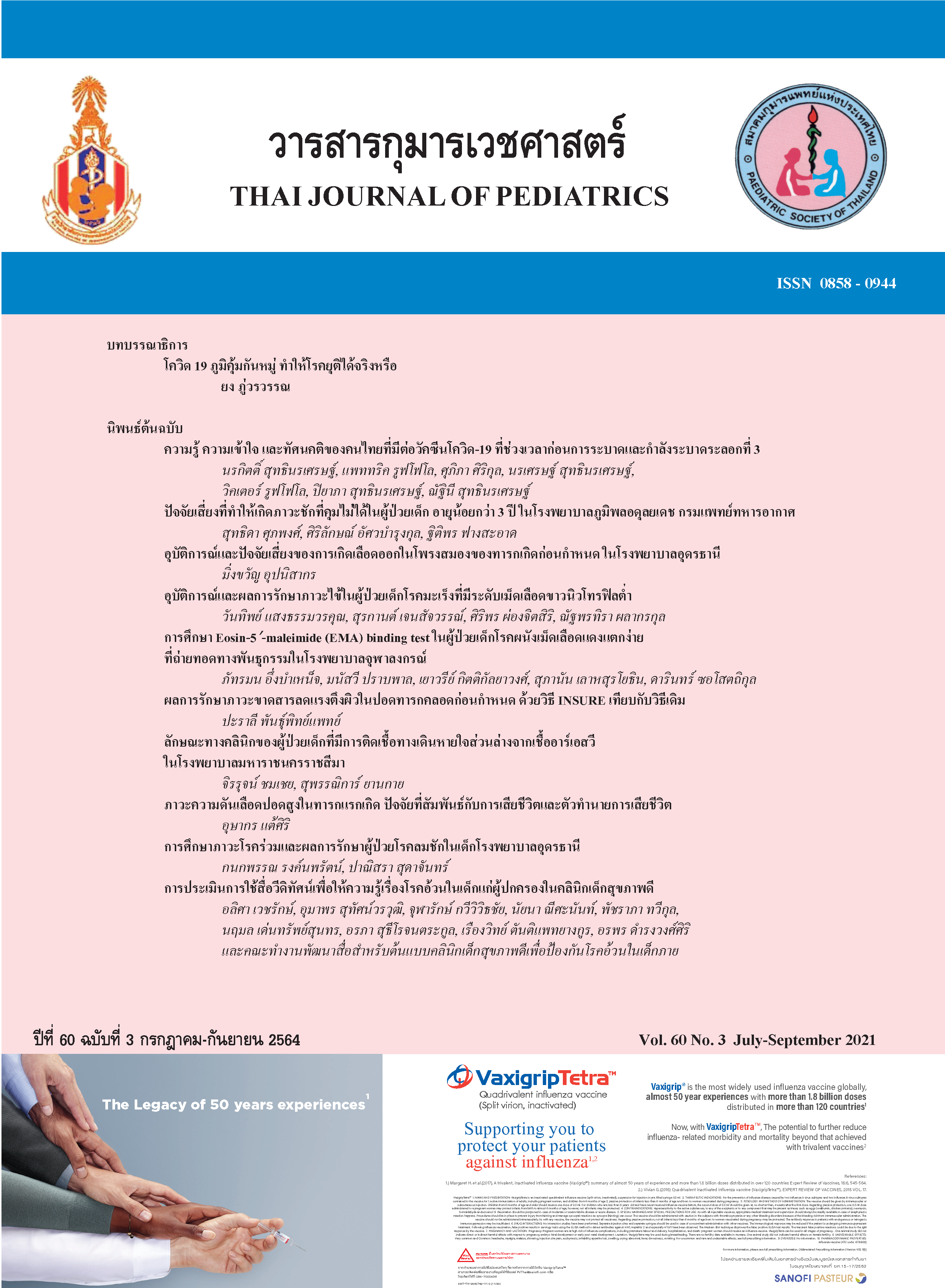Eosin-5′-maleimide (EMA) binding test in hereditary red blood cell membrane defects patients in Chulalongkorn Memorial Hospital
Keywords:
Hereditary red blood cell membrane defect, hereditary spherocytosis, Eosin- 5′-maleimide binding testAbstract
Objective: Hereditary red blood cell membrane defects are inherited disease due to mutations in various membrane or skeletal proteins. The common congenital red blood cell membrane defects included hereditary spherocytosis (HS), southeast asian ovalocytosis (SAO), hereditary elliptocytosis (HE) and hereditary pyropoikilocytosis (HPP). The old and the classic methods used for the diagnosis is based on osmotic fragility test (OFT). OFT is labor intensive and lack of sensitivity. We evaluated the performance the Eosin-5′-maleimide (EMA) binding test to replace the classic OFT.
Method: Fourteen patients with hereditary red blood cell membrane defects (7 cases with HS, 4 cases with SAO and 3 cases with HE) were enrolled. All these patients and 39 cases of other hemolytic anemia underwent EMA binding test. 93 cases were analyzed as the
control group.
Result: In the EMA binding test, %Mean Fluorescence Intensity (MFI) in HS cases = 68.08 (SD 8.54), HE cases = 89.36 (SD 5.57), other hemolytic anemia cases = 96.10 (SD 6.94) and normal control groups = 100.33 (SD 5.55), respectively. In HS and SAO cases, the
%MFI were significantly low compared to HE cases, other hemolytic anemia cases and normal control groups, respectively (P < .001). Conclusion: EMA binding test was an accurate and relative faster method to confirm diagnosed HS and SAO.
Downloads
References
Mohandas N, Evans E. Mechanical properties of the red cell membrane in relation to molecular structure and genetic defects. Annu Rev Biophys Biomol Struct. 1994; 23: 787-818.
Perrotta S, Gallagher PG, Mohandas N: Hereditary spherocytosis. Lancet 2008; 372: 1411–1426.
Bolton-Maggs PH, Langer JC, Iolascon A, Tittensor P, King MJ. General Haematology Task Force of the British Committee for Standards in Haematology: Guidelines for the diagnosis and management of hereditary spherocytosis – 2011 update. Br J Haematol 2012; 156: 37–49.
Perrotta S, Gallagher PG, Mohandas N. Hereditary spherocytosis. The Lancet. 2008; 372 (9647):1411-1426.
An X, Mohandas N. Disorders of red cell membrane. Br J Haematol 2008; 141:367-75.
Narla J, Mohandas N. Red cell membrane disorders. Int J Lab Hematol 2017;39 Suppl1:47-52.
Bolton-Maggs PH, Stevens RF, Dodd NJ, Lamont G, Tittensor P, King MJ. Guidelines for the diagnosis and management of hereditary spherocytosis. Br J Haematol 2004; 126:455-74.
R D Arora , J Dass , S Maydeo , V Arya , N Radhakrishnan , A Sachdeva , J Kotwal , M Bhargava. Flow cytometric osmotic fragility test and eosin-5’-maleimide dye-binding tests are better than conventional osmotic fragility tests for the diagnosis of hereditary spherocytosis. Int J Lab Hematol. Int J Lab Hematol 2018 Jun; 40(3):335-342.
Sang Hyuk Park , Chan-Jeoung Park, Bo-Ra Lee , et all. Comparison study of the eosin-5’-maleimide binding test, flow cytometric osmotic fragility test, and cryohemolysis test in the diagnosis of hereditary spherocytosis. Am J Clin Pathol 2014 Oct; 142(4):474-84
Downloads
Published
How to Cite
Issue
Section
License

This work is licensed under a Creative Commons Attribution-NonCommercial-NoDerivatives 4.0 International License.



